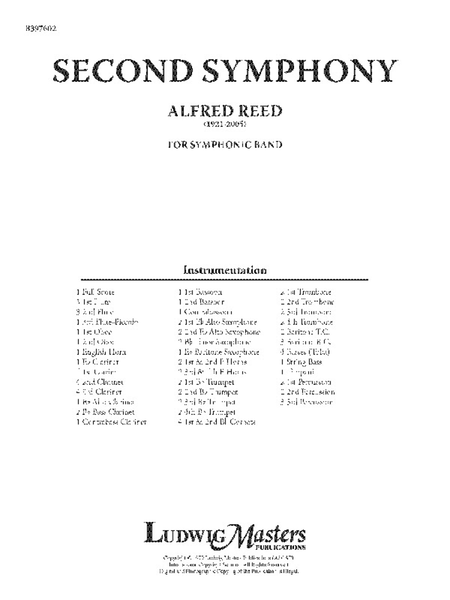Second Symphony
-
Ships in 6 to 8 weeks
Details
Description
SKU: AP.36-B397601
Composed by Alfred Reed. Concert Band; Performance Music Ensemble; Single Titles. Ludwig Masters. Concert Band Classics. Score. LudwigMasters Publications #36-B397601. Published by LudwigMasters Publications (AP.36-B397601).English.
Commissioned in the late Fall of 1975, work on the SECOND SYMPHONY was not begun until the Summer of 1977, when the score was completed in sketch form in three months, July through September. The instrumentation was begun in the late Winter of that same year and the Full Score completed on March 27th, 1978. The first performance took place in Fairchild Auditorium on the campus of Michigan State University on May 6th, 1978, by the Michigan State University Symphonic Band under the direction of Kenneth G. Bloomquist.
The symphony is a single-movement work embracing three distinct sections. The first, marked Lento (ma ritmico), is a freely constructed passacaglia built on a flowing theme derived from the tone row that underlies the entire score: Bb-F-E-Ab-G-D-Db-C-Cb-Gb-Eb-A, and which is developed in alternating variations leading to a powerful climax at its close. The second section is, in reality, a tense, hard-driving double fugue characterized by a constant march-like rhythm underlying the further development of the original theme and its countersubject in both duple and triple meters. This section, marked Allegro con fuoco, also ends in an overwhelming climax and then dies away, preparing for the third and final section. This final portion of the music, marked Molto moderato e sostenuto, is based upon two long, lyric themes, also derived from the row, that alternate with occasional reminders of some of the thematic material from the second section, now transformed into a rich, glowing and relaxed tonal tapestry woven together from the myriad of tonal colors available in contemporary scoring practice for the winds. At the very end, after a fortissimo re-statement of the theme in its original form as derived from the row, there is a gradual ebbing of the flood of tone from the full ensemble as the various choirs drop out one by one, leaving only a dark, warm color of low Clarinets, Baritone and Tuba, hinting at the opening of the.
These products are currently being prepared by a new publisher. While many items are ready and will ship on time, some others may see delays of several months.

 Share
Share